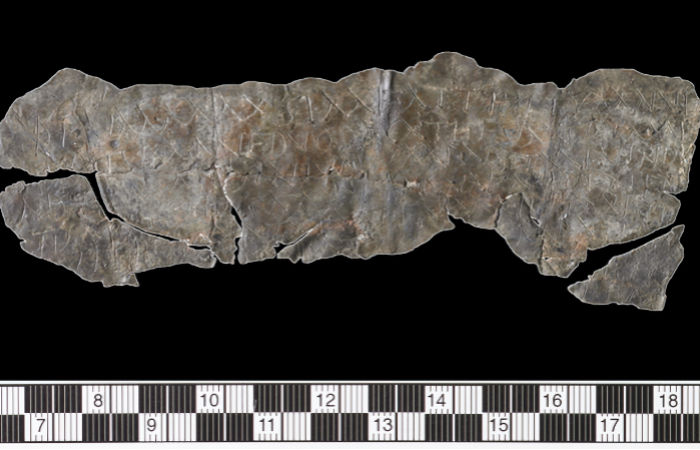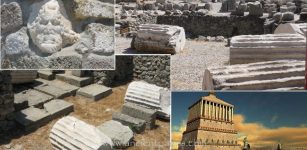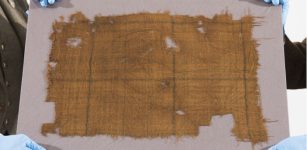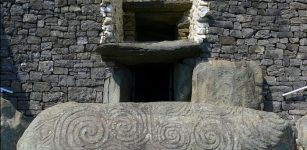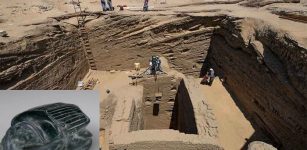Intriguing Connection Between Ancient Curse Tablets And The Book Of Revelation Discovered
Jan Bartek - AncientPages.com - Curse tablets were popular and widely used in the ancient world. The corresponding incantations were often inscribed or carved on thin sheets of lead – with the intention that these would then cause harm to an opponent or rival. The use of curse tablets and the associated rituals spread as the Roman Empire expanded and have been found at sites all the way from Egypt to Britain. They were used by both the uneducated and those of higher status.
Curse tablet cursing Priscilla from Groß-Gerau: The lead tablet, here the front side, consists of three fragments and is inscribed on both sides with a prayer for revenge in Latin. It probably dates from around 100 AD. Credit photo/©: René Müller / LEIZA
A research project headed by Dr. Michael Hölscher of Johannes Gutenberg University Mainz (JGU) is investigating curse tablets and the role they play in the Book of Revelation, the final book of the New Testament. "There are aspects of curse tablet-related inscriptions and practices in Revelation. This may well have been an indirect expression of the need for segregation and the attempt at self-preservation of an often threatened early Christian community," explained Hölscher, a researcher at the JGU Faculty of Catholic Theology.
The research project entitled "Disenchanted Rituals. Traces of the Curse Tablets and Their Function in the Revelation of John" is being sponsored by the German Research Foundation (DFG) over the period 2022 to 2025.
Curse rituals were part of everyday life in wide areas of the Roman Empire over a period of 1,000 years
Curse tablets began to be systematically compiled and investigated in the 19th century. However, previously unknown versions of these spells on little lead sheets are continually being uncovered and deciphered. Some 1,700 of these have to date been collated and provide insights into the culture and language of those ancient people who placed their reliance on them. The archaeological finds originate from an era dating from roughly 500 BCE to 500 CE. In other words, the rituals were being performed over about 1,000 years in a region stretching from the Mediterranean to the far north of Europe. Those curse tablets were targeted at opposing litigants in court cases, sporting adversaries in the hippodrome, or rivals in amorous affairs.
The lead tablets with their inscribed curses were often deposited in specific places, such as graves or in the vicinity of sacred locations, the assumed abodes of spirits of the underworld, who would ensure the effectiveness of the curse.
"The curse ritual as a whole was not simply restricted to the wording of the spell as such, but would have also involved the act of writing it down, the piercing of the tablets, or their burial in deliberately selected places," said Hölscher describing aspects of the tabella defixionis practice. The ancients considered it a form of witchcraft or black magic, which were prescribed under Roman law.
Parallels between curse tablets and the text of Revelation
Aided by his insights into the phrasing used by those employing curse tablets and their expectations as to how their curses were supposed to work, Hölscher has been looking at how these have left their traces in the text of the Revelation of John. This was written in the 1st century CE and was addressed to the Christians on the western coast of Asia Minor. "In Revelation, we find wording and phrases that are very similar to those that appeared on curse tablets, although no actual verbatim quotations from the latter appear," Hölscher pointed out.
As an example, he cites the description of an angel that casts a vast stone into the sea with the words: "Thus with violence shall that great city Babylon be thrown down, and shall be found no more at all."
According to Hölscher, this can be read as a kind of curse ritual. Those confronted with these words at the time could well have directly associated them with the routine use of curse tablets with which they would have been familiar.
In the seven letters of the Book of Revelation, Roman rule and the cult of the emperor are portrayed as demonic, satanic phenomena, from which the Christian minority was striving to isolate itself. "The Book of Revelation contributes to the process of self-discovery, the seeking of a distinctive identity by a Christian minority in a world dominated by a pagan Roman majority that rendered routine homage not only to the emperor but also to the main Roman gods", explained Hölscher.
The DFG-funded project "Disenchanted Rituals" looks for analogies between the Book of Revelation and curse tablets and analyzes the way that readers of the late first century CE might have interpreted the Bible text.
"It is possible that those who read or listened to the words of the Apocalypse of John could readily have seen whole passages, single phrases, or concepts in the light of curse spells," said Hölscher, emphasizing the influence of the curse tablet culture. The project will investigate the overlap of the two sources against the background of how magic on the one hand and religion on the other were perceived in antiquity.
Original story - University of Seville - via EurekAlert
Written by Jan Bartek - AncientPages.com Staff Writer

